Identification of TAZ as the essential molecular switch in orchestrating SCLC phenotypic transition and metastasis
- PMID: 35967587
- PMCID: PMC9365451
- DOI: 10.1093/nsr/nwab232
Identification of TAZ as the essential molecular switch in orchestrating SCLC phenotypic transition and metastasis
Erratum in
-
Correction to: Identification of TAZ as the essential molecular switch in orchestrating SCLC phenotypic transition and metastasis.Natl Sci Rev. 2023 Dec 28;10(12):nwac224. doi: 10.1093/nsr/nwac224. eCollection 2023 Dec. Natl Sci Rev. 2023. PMID: 38155833 Free PMC article.
Abstract
Small-cell lung cancer (SCLC) is a recalcitrant cancer characterized by high metastasis. However, the exact cell type contributing to metastasis remains elusive. Using a Rb1 L/L /Trp53 L/L mouse model, we identify the NCAMhiCD44lo/- subpopulation as the SCLC metastasizing cell (SMC), which is progressively transitioned from the non-metastasizing NCAMloCD44hi cell (non-SMC). Integrative chromatin accessibility and gene expression profiling studies reveal the important role of the SWI/SNF complex, and knockout of its central component, Brg1, significantly inhibits such phenotypic transition and metastasis. Mechanistically, TAZ is silenced by the SWI/SNF complex during SCLC malignant progression, and its knockdown promotes SMC transition and metastasis. Importantly, ectopic TAZ expression reversely drives SMC-to-non-SMC transition and alleviates metastasis. Single-cell RNA-sequencing analyses identify SMC as the dominant subpopulation in human SCLC metastasis, and immunostaining data show a positive correlation between TAZ and patient prognosis. These data uncover high SCLC plasticity and identify TAZ as the key molecular switch in orchestrating SCLC phenotypic transition and metastasis.
Keywords: SWI/SNF complex; TAZ; metastasis; phenotypic transition; small cell lung cancer.
© The Author(s) 2022. Published by Oxford University Press on behalf of China Science Publishing & Media Ltd.
Figures
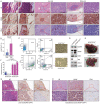

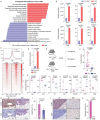
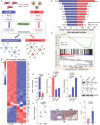
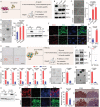
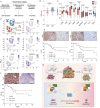
Similar articles
-
Correction to: Identification of TAZ as the essential molecular switch in orchestrating SCLC phenotypic transition and metastasis.Natl Sci Rev. 2023 Dec 28;10(12):nwac224. doi: 10.1093/nsr/nwac224. eCollection 2023 Dec. Natl Sci Rev. 2023. PMID: 38155833 Free PMC article.
-
[SWI/SNF Complex Gene Mutations Promote the Liver Metastasis of Non-small Cell Lung Cancer Cells in NSI Mice].Zhongguo Fei Ai Za Zhi. 2023 Oct 20;26(10):753-764. doi: 10.3779/j.issn.1009-3419.2023.102.35. Zhongguo Fei Ai Za Zhi. 2023. PMID: 37989338 Free PMC article. Chinese.
-
YAP and TAZ modulate cell phenotype in a subset of small cell lung cancer.Cancer Sci. 2016 Dec;107(12):1755-1766. doi: 10.1111/cas.13078. Epub 2016 Nov 25. Cancer Sci. 2016. PMID: 27627196 Free PMC article.
-
The Hippo Signaling Core Components YAP and TAZ as New Prognostic Factors in Lung Cancer.Front Surg. 2022 Mar 21;9:813123. doi: 10.3389/fsurg.2022.813123. eCollection 2022. Front Surg. 2022. PMID: 35388363 Free PMC article. Review.
-
Beyond Mutations: Additional Mechanisms and Implications of SWI/SNF Complex Inactivation.Front Oncol. 2015 Feb 27;4:372. doi: 10.3389/fonc.2014.00372. eCollection 2014. Front Oncol. 2015. PMID: 25774356 Free PMC article. Review.
Cited by
-
Killing SCLC: insights into how to target a shapeshifting tumor.Genes Dev. 2022 Mar 1;36(5-6):241-258. doi: 10.1101/gad.349359.122. Genes Dev. 2022. PMID: 35318269 Free PMC article. Review.
-
PHD finger protein 10 promotes cell proliferation by regulating CD44 transcription in gastric cancer.Heliyon. 2024 Apr 3;10(7):e29109. doi: 10.1016/j.heliyon.2024.e29109. eCollection 2024 Apr 15. Heliyon. 2024. PMID: 38601625 Free PMC article.
-
Autophagic flux modulates tumor heterogeneity and lineage plasticity in SCLC.Front Oncol. 2025 Jan 9;14:1509183. doi: 10.3389/fonc.2024.1509183. eCollection 2024. Front Oncol. 2025. PMID: 39850810 Free PMC article.
-
Immunotherapy in Extensive-Stage Small Cell Lung Cancer.Curr Oncol. 2021 Oct 12;28(5):4093-4108. doi: 10.3390/curroncol28050347. Curr Oncol. 2021. PMID: 34677265 Free PMC article. Review.
-
Integrative study of lung cancer adeno-to-squamous transition in EGFR TKI resistance identifies RAPGEF3 as a therapeutic target.Natl Sci Rev. 2024 Nov 7;11(12):nwae392. doi: 10.1093/nsr/nwae392. eCollection 2024 Dec. Natl Sci Rev. 2024. PMID: 39687207 Free PMC article.
References
LinkOut - more resources
Full Text Sources
Molecular Biology Databases
Research Materials
Miscellaneous
